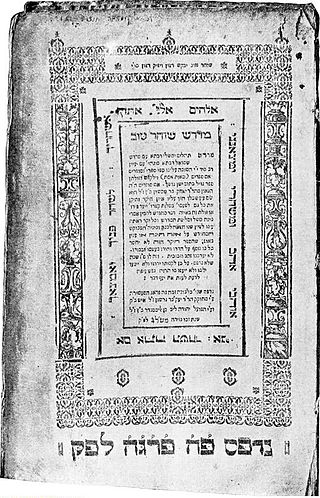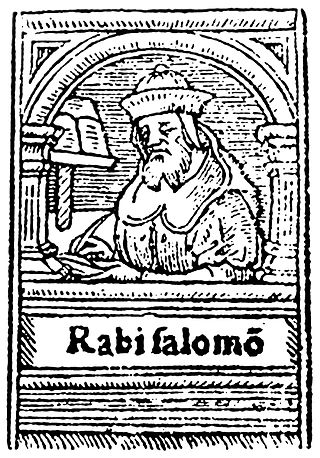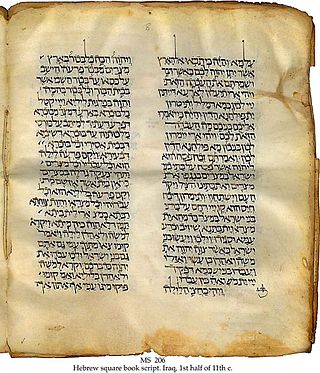Related Research Articles

Midrash is expansive Jewish Biblical exegesis using a rabbinic mode of interpretation prominent in the Talmud. The word itself means "textual interpretation", "study", or "exegesis", derived from the root verb darash (דָּרַשׁ), which means "resort to, seek, seek with care, enquire, require", forms of which appear frequently in the Hebrew Bible.

Shlomo Yitzchaki, generally known by the acronym Rashi, was a medieval French rabbi, the author of comprehensive commentaries on the Talmud and Hebrew Bible.

The Hebrew Bible or Tanakh, also known in Hebrew as Miqra, is the canonical collection of Hebrew scriptures, including the Torah, the Nevi'im, and the Ketuvim. Different branches of Judaism and Samaritanism have maintained different versions of the canon, including the 3rd-century BCE Septuagint text used in Second Temple Judaism, the Syriac Peshitta, the Samaritan Pentateuch, the Dead Sea Scrolls, and most recently the 10th-century medieval Masoretic Text compiled by the Masoretes, currently used in Rabbinic Judaism. The terms "Hebrew Bible" or "Hebrew Canon" are frequently confused with the Masoretic Text; however, this is a medieval version and one of several texts considered authoritative by different types of Judaism throughout history. The current edition of the Masoretic Text is mostly in Biblical Hebrew, with a few passages in Biblical Aramaic.

The Talmud is the central text of Rabbinic Judaism and the primary source of Jewish religious law (halakha) and Jewish theology. Until the advent of modernity, in nearly all Jewish communities, the Talmud was the centerpiece of Jewish cultural life and was foundational to "all Jewish thought and aspirations", serving also as "the guide for the daily life" of Jews.

A targum was an originally spoken translation of the Hebrew Bible that a professional translator would give in the common language of the listeners when that was not Biblical Hebrew. This had become necessary near the end of the first century BC, as the common language was Aramaic and Hebrew was used for little more than schooling and worship. The translator frequently expanded his translation with paraphrases, explanations and examples, so it became a kind of sermon.

Rabbinic literature, in its broadest sense, is the entire spectrum of rabbinic writings throughout Jewish history. However, the term often refers specifically to literature from the Talmudic era, as opposed to medieval and modern rabbinic writing, and thus corresponds with the Hebrew term Sifrut Chazal. This more specific sense of "Rabbinic literature"—referring to the Talmudim, Midrash, and related writings, but hardly ever to later texts—is how the term is generally intended when used in contemporary academic writing. The terms mefareshim and parshanim (commentaries/commentators) almost always refer to later, post-Talmudic writers of rabbinic glosses on Biblical and Talmudic texts.

Torah study is the study of the Torah, Hebrew Bible, Talmud, responsa, rabbinic literature, and similar works, all of which are Judaism's religious texts. According to Rabbinic Judaism, the study is done for the purpose of the mitzvah ("commandment") of Torah study itself.

Targum Onkelos is the primary Jewish Aramaic targum ("translation") of the Torah, accepted as an authoritative translated text of the Five Books of Moses and thought to have been written in the early second century CE.
A Torah database is a collection of classic Jewish texts in electronic form, the kinds of texts which, especially in Israel, are often called "The Traditional Jewish Bookshelf" ; the texts are in their original languages. These databases contain either keyed-in digital texts or a collection of page-images from printed editions. Given the nature of traditional Jewish Torah study, which involves extensive citation and cross-referencing among hundreds of texts written over the course of thousands of years, many Torah databases also make extensive use of hypertext links.

Brook of Egypt is the name used in some English translations of the Bible for the Hebrew נַחַל מִצְרַיִם, naḥal mizraim, a river (bed) forming the southernmost border of the Land of Israel. A number of scholars in the past identified it with Wadi el-Arish, an epiphemeral river flowing into the Mediterranean sea near the Egyptian city of Arish, while other scholars, including Israeli archaeologist Nadav Na'aman and the Italian Mario Liverani believe that the Besor stream, just to the south of Gaza, is the "Brook of Egypt" referenced in the Bible. A related phrase is nahar mizraim, used in Genesis 15:18.

Chumash is a Torah in printed and book bound form as opposed to a Sefer Torah, which is a scroll.

A Mikraot Gedolot, often called the "Rabbinic Bible" in English, is an edition of the Hebrew Bible that generally includes three distinct elements:
The Living Torah and The Living Nach are popular, clear and modern English translations of the Tanakh based on traditional Jewish sources, along with extensive notes, maps, illustrations, diagrams, charts, bibliography, and index.
Hebrew Bible English translations are English translations of the Hebrew Bible (Tanakh) according to the Masoretic Text, in the traditional division and order of Torah, Nevi'im, and Ketuvim. Most Jewish translations appear in bilingual editions (Hebrew–English).
Soncino Press is a Jewish publishing company based in the United Kingdom that has published a variety of books of Jewish interest, most notably English translations and commentaries to the Talmud and Hebrew Bible. The Soncino Hebrew Bible and Talmud translations and commentaries were widely used in both Orthodox and Conservative synagogues until the advent of other translations beginning in the 1990s.

Bible translations into Aramaic covers both Jewish translations into Aramaic (Targum) and Christian translations into Aramaic, also called Syriac (Peshitta).
Shnayim mikra ve-echad targum, is the Jewish practice of reading the weekly Torah portion in a prescribed manner. In addition to hearing the Torah portion read in the synagogue, a person should read it himself twice during that week, together with a translation usually by Targum Onkelos and/or Rashi's commentary. In addition, while not required by law, there exists an Ashkenazi custom to also read the portion from the Prophets with its targum.

Sifrei Kodesh, commonly referred to as sefarim, or in its singular form, sefer, are books of Jewish religious literature and are viewed by religious Jews as sacred. These are generally works of Torah literature, i.e. Tanakh and all works that expound on it, including the Mishnah, Midrash, Talmud, and all works of halakha, Musar, Hasidism, Kabbalah, or machshavah. Historically, sifrei kodesh were generally written in Hebrew with some in Judeo-Aramaic or Arabic, although in recent years, thousands of titles in other languages, most notably English, were published. An alternative spelling for 'sefarim' is seforim.
The following outline is provided as an overview of and topical guide to Judaism:

The Pentateuch with Rashi's Commentary Translated into English, was first published in London from 1929 to 1934 and is a scholarly English language translation of the full text of the Written Torah and Rashi's commentary on it. The five-volume work was produced and annotated by Rev. M. Rosenbaum and Dr Abraham M. Silbermann in collaboration with A. Blashki and L. Joseph. The work has an extensive appendix of notes which display notable critical scholarship; the authors tackle difficult comments of Rashi. All the Hebrew text, including the Rashi, is in pointed non-Rashi font. The work is commonly known today as "Silberman's Rashi".
References
- ↑ "Mikra'ot Gedolot". Ucalgary.ca. Retrieved 2014-06-03.
- ↑ Megilla 3a
- ↑ Encyclopaedia Judaica:Bible:Targum Onkelos:third paragraph
- ↑ Bavli, Megilla, 3a as understood by the Marshah, Chidushai Agadot on Nedorim, 9b. See also the Yam Shel Shlomo on Yebomot chapter 12
- ↑ Encyclopaedia Judaica: Bible
- 1 2 ר' נתן מרקוס הכהן אדלר , nechama.org.il
- ↑ Encyclopaedia Judaica, 2nd ed., vol. 3, p. 591
- ↑ Eisenstein's Otzer Yisrael, v. 10 p. 308
- ↑ Deborah Abecassis (March 1999). "Reconstructing Rashi's Commentary on Genesis from Citations in the Torah Commentaries of the Tosafot" (Document). McGill University. pp. Page i.
- ↑ Berenbaum, Michael; Skolnik, Fred, eds. (2007). "Rashi". Encyclopaedia Judaica . Vol. 17 (2nd ed.). Detroit: Macmillan Reference. p. 103. ISBN 978-0-02-866097-4.
- ↑ Rashi's commentary on Genesis 3,8
- ↑ Nosson Scherman, ed. (2000). The Chumash (Stone ed.). Brooklyn, NY: Mesorah Publications Ltd. ISBN 0-89906-014-5.
- ↑
- Kaufmann, Eine unbekannte messianische Bewegung unter den Juden, in Jahrbuch für Jüdische Geschichte und Literatur, i. 148 et seq., Berlin, 1898
- ↑ "Ibn Ezra, Abraham". The Online Jewish Encyclopedia. 1901–1906.
- ↑ Talmage, Frank (2007). "Kimhi, David". In Berenbaum, Michael; Skolnik, Fred (eds.). Encyclopaedia Judaica . Vol. 12 (2nd ed.). Detroit: Macmillan Reference. pp. 155–156. ISBN 978-0-02-866097-4.
- ↑ "Radak (Rabbi David Kimchi)".
- ↑ Encyclopaedia Judaica 2nd ed. vol 14 page 741
- ↑ Encyclopaedia Judaica 2nd ed. vol 14 page 745
- ↑ Encyclopaedia Judaica 2nd ed. vol. 11 page 31
- ↑ Eisenstein's Ozer Yisrael vol. 6 page 11
- ↑ Lawee, Eric; Grossman, Avraham. Encyclopaedia Judaica. Vol. 1 (2nd ed.). pp. 276–278.
- ↑ Jewish Encyclopedia in the section on Altschul
- ↑ Pfeffer, Jeremy L. (2003). "Translator's Introduction". Malbim's Job. Jersey City NJ: KTAV. pp. 10–11. ISBN 0-88125-801-6.
- ↑ Encyclopaedia Judaica. Vol. 6 (2nd ed.). Keter. p. 468.
- ↑ Encyclopaedia Judaica , second edition, volume 12, page 621
- ↑ Rosenberg, Avroham Yoseif. "The Complete Jewish Bible, With Rashi Commentary". The Complete Tanach With Rashi. Judaica Press . Retrieved 24 July 2013.
- ↑ Judaica Press Prophets & Writings Archived December 11, 2008, at the Wayback Machine
- ↑ Rosenberg, Avroham Yoseif. "The Complete Jewish Bible, With Rashi Commentary (in Hebrew and English)". Classic Texts. Judaica Press & Chabad.org. Retrieved 24 July 2013.
- ↑ JPS Tanakh: The Holy Scriptures (blue): 1st edition. 1985. ISBN 0827603665.
November 1, 1985
- ↑ "JPS Bible Translation Enters Digital Era with Sefaria". May 11, 2017.
- ↑ "URJ Books And Music :: Sacred Texts :: Torah: A Women's Commentary, The". Archived from the original on 21 August 2014. Retrieved 19 October 2014.
- ↑ "The Women's Torah Commentary: New Insights from Women Rabbis on the 54 Weekly Torah Portions". Jewishlights.com. Retrieved 2014-06-03.
